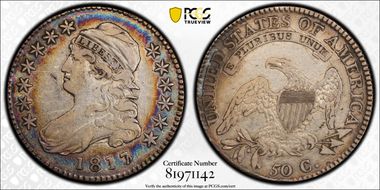John H. Cochrane (1817-1859), Letitia Kelley (1817-1885) 的钱币相册
The 1817 Newcomb 13 Large Cent is a common variety in all grades including Mint State. Large Cent expert, John Wright, estimates that there may be as many as "hundreds" of Mint State examples in existence today. Based on that expansive population, Wright believes this variety may have been included in the Randall Hoard, famous as the source of many Uncirculated Middle Date Large Cents. Wright calls this variety the "Lazy C" because the C of CENT is rotated far to the right relative to the E. Early states of this variety have full denticles and sharp stars. As the dies wore, the denticles become mushy and indistinct, and the outer points of the stars began to stretch out toward the border. Most Mint State examples are Brown, with perhaps a small amount of original red color. Red and Brown examples are decidedly scarce and there are no full Red examples known. The finest example is the PCGS MS66BN from the D. Brent Pogue Collection.
The 1817/3 Half Dollar is an enigmatic overdate that defies explanation. If it were a leftover die from 1813, one would expect the 13th obverse star to show the notched point that is believed to be the "signature" of engraver John Reich. Reich resigned his position in March 1817, after which the notching of the stars ended. This suggests that the new engraver simply made an error by punching a 3 into the die, then corrected it with the proper 7 punch. But, why would the engraver have picked up a punch for a 3? That would have been an egregious oversight on the engraver's part, especially since he was four year's away from a need for a 3, plus there is no U.S. coin from 1817 where a 3 might be used in either a legend, motto, or denomination. Regardless of the reason for this variety, it is extremely popular with collectors. Only one die combination (Overton 101, and it's later die state Overton 101a) utilize this obverse. In most grades, the 1817/3 Half Dollar is fairly common, but in Mint State, it becomes very rare.





















